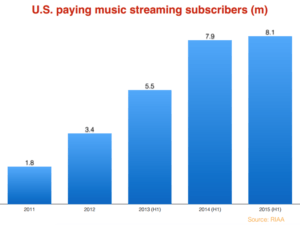Music Unlimited – Sony Lost This One As Well

Sony had all the hard components needed for a streaming service and it launched one 4 years before Apple but lack of understanding in user expectations cost them to turn the service down.
Introduction and Background
I grew up on Sony devices, appreciating the brand, high quality, sophisticated engineering, thought in every detail and had many cheerful childhood memories with Sony Walkman. I also visited Sony Computer Science Labs in Tokyo, Japan on 1/24/2017 and I met amazing people there. Despite all my love to the brand, I must declare Sony as a loser in digital transformation. I will focus on one of the major segments: music. However, I think the lack of efficient digital strategies in the music branch apply to other branches of Sony Corp.
Sony Walkman
Sony Music Entertainment (SME) is an American music company and a wholly owned subsidiary of Sony Corporation. SME owns prominent labels around the world such as Columbia Records, RCA Label group etc. Through these labels, they produce hundreds of artists, including Shakira, Jimi Hendrix, Foo Fighters etc. SME has traditionally followed a vertical approach, utilizing technologies and products of parent Sony Corporation. It has had capability to produce and distribute their own physical copies of CD’s, develop and market music players such as Walkman and their own software to play music. Therefore, when Sony Corp Launched its own music subscription service Music Unlimited in the US, Australia and New Zealand on Feb. 17, 2011, it was not only about the consumer electronic devices on which the platform was going to be run but also very much about the SME and the companies press release read: “Users can play music any time through “Music Unlimited powered by Qriocity” on a wide variety of Internet-connected Sony devices including Sony’s 2010 and 2011 models of network-enabled BRAVIA® TV, Blu-ray Disc™ player, Blu-ray Disc Home Theater system, PlayStation®3 computer entertainment system as well as VAIO and other personal computers. All existing PlayStation 3 computer entertainment systems in these countries will have access to the service. It will also become available on a wide range of Sony’s portable devices, as well as on Sony and third-party Android-based mobile devices and other portable devices.” [1]
Sony Music Unlimited Logo
Digital Strategy
The strategy was to leverage variety of devices that Sony Corporation had produced, combined with rich labels Sony Music controlled and provide an alternative way to listen music for consumers by streaming over servers controlled by Sony. Service had wide access, almost every song that is available on Spotify could be found on Music Unlimited. It also had the above mentioned advantage over Spotify as Sony had control on some of the consumer electronics market, especially a large portion of the gaming consoles hence Sony could pre install the relevant software before shipping the product. Although, this strategy seemed to make sense, Sony Music Unlimited failed to do well and the service was closed by March 29, 2015 [2].
Why the Strategy Failed
In my opinion, the following factors of Music Unlimited clearly indicate a lack of understanding on consumer behavior and expectations:
- It asked for a credit card immediately and it had no free version. It offered 1 month free services and had two paid versions: 5$ a month, “The Access Plan” limited the consumer to streaming music on a PlayStation 4 or 3 whereas 10$ a month, “Premium Plan” let the users listen to the music over their Apple or Android devices. As shown in the figure below, the paid subscription business model did not converge on the consumer side by that time. (As an additional note, Apple music also does not offer a free plan but it offers a 3 month test period. Apple Music costs $9.99 per month, or $14.99 per month for a family subscription for up to six people, $4.99 for students)
Number of paying music streaming subscribers in the US
- Poor user experience. We know that small differences in user experience can define the entire industry in software (Snapchat, Instagram were only slight improvements in user experience but gained significant market share). Sony chose to develop a web based app for PC and Mac which were reviewed to be slow. Android and iOS apps also failed to receive good reviews. [3][4][5]
I’d like to point out Music Unlimited was on the market almost 4 years before Apple Music, which as of November 2016 had 13 million subscribers, up from 11 million for February 2016. Even though software development is not as technically complicated as hardware development, history shows that traditional hardware companies miss the importance of user experience and make simple errors. Digital transformation requires a customer centric approach and is not forgiving of such errors.
[2] http://blog.us.playstation.com/2015/01/28/playstation-meet-spotify/
[3] http://www.digitaltrends.com/music/sony-music-unlimited-review-its-actually-quite-limited/
[4] http://www.pcmag.com/article2/0,2817,2421119,00.asp
[5] http://www.pcmag.com/article2/0,2817,2401747,00.asp
[6] http://www.zdnet.com/article/hands-on-review-sonys-music-unlimited-powered-by-qriocity-updated/






This is a very interesting post. I didn’t realize that this service even existed, and I interned at Spotify this past summer. I guess that speaks to how fleeting this was and how non-threatening it was to Spotify’s business. At some point, Sony must have decided that they were not positioned well to execute this product; they actually ended up investing in Spotify (the three major labels collectively own ~10+% of the company). I think this happened well before they officially killed the product. While Sony did have a lot of relevant assets for a music streaming service, they lacked the talent and processes needed to build and iterate a successful product. I think they may have been better off acquiring a streaming service (e.g., Tidal), instead of building one organically.
Sony’s efforts in this space was news to me as well. I agree with Alex that Sony’s failure to integrate across its assets has a lot to do with the way the company manages talent and innovation. Regarding the comparison to Apple Music – while Apple’s service was a late entrant, it targeted customers already addicted to an ecosystem. The members were already buying digital content through iTunes before the music service was launched. So Apple had to market its new offering well, and ensure that the service was fully-integrated into iTunes. Perhaps, had Sony also offered movies from its production houses and access to video games under a subscription model through the same platform, customers would have seen more value that justified the switching costs.